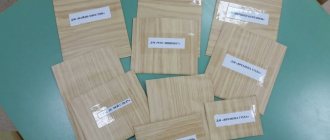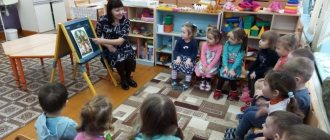Questioning.
- To identify the child's gaming interests and preferences at home, questionnaires or interviews with parents are used. II. Questions for parents: 1. Does your child often play at home? What games do you play most often? 2. Do you offer your child to play a specific game, do you insist if he does not express a special desire? 3.How do you do this? How do you choose games for your child? 4. How often do you offer your child a game plot that is new to him or does he offer it himself? Where do you think a child’s play stories come from? 5. Do you know which toys are most interesting to your child? 6. How much time a day does your child play independently? 7. Do you allow your child to play some games that are interesting to him, but which you don’t like? The following questionnaire is aimed at studying how teachers take into account children’s gaming interests when organizing role-playing games. III.Questions for educators: 1. Do you diagnose the gaming interests and preferences of your students? How do you do it? 2. Do you use diagnostic results for role-playing games? 3. How do you plan children's play activities (taking into account children's interests, without interests) 4. Do you insist that children play the games offered by the program? Do you think these games are always interesting for children? 5. How often do you offer children new game stories? Where do they come from? 6. Do you select game attributes for games, how do you do this? 7. Is there everything needed in the play area in your group for role-playing games? Does the content of this area correspond to the play interests of children? 8. Do you allow your children to play some games that are interesting to them if you don’t like them? Questionnaire for parents
Questions
Answer options Does your child often play at home? Yes No Your own option Do you know which toys are most interesting to your child? Yes No Your own option Do you allow your child to play some games that are interesting to him, but which you don’t like? Yes No Your own option How much time a day does your child play independently? Less than 1 hour 1 to 2 hours Your own option How often do you offer your child a game plot that is new to him or does he offer it himself? I offer it as needed Selects independently Your own option Where do you think a child’s play stories come from? From kindergarten games Television and computer games Your own option What games does your child play most often? desktop Role-playing Your own option Do you offer your child to play a specific game? Yes No Your own option Do you insist on choosing a game if he doesn’t express any particular desire? Yes No Your own option How do you choose games for your child? At your own discretion At the child's discretion Your own option Questioning of teachers
questions Answer options You diagnose the gaming interests and preferences of your students Yes No Your own option Do you use diagnostic results to organize a role-playing game? Yes No Your own option How do you plan children's play activities? Taking into account children's interests Clearly according to program recommendations Your own option Do you insist that children play the games offered by the program? Yes No Your own option Do you think these games are always interesting for children? Yes, sure No, but the program requires Your own option How often do you offer children new game stories? Until the child gets tired of the same plot of the game I try to offer a story once every 1 - 2 weeks Your own option Where do these stories come from? From the program from observations of children’s games and conversations with each other Your own option Do you select game attributes for games, how do you do this? Yes, we create attributes together with children No, we only use improvised means Your own option Is there everything you need in the play area in your group for role-playing games? Yes No (what exactly is missing) Your own option Does the content of this area correspond to the play interests of children? Yes No (what exactly does not match) Your own option Do you allow your children to play some games that are interesting to them if you don’t like them? Yes, sure Definitely no Yours in - Questions to talk with your child
1. Do you like to play? What are your favorite games, please name them?
2. Do you like the games you play with the kids in kindergarten? What about at home? What do you play at home?
3. Who are you most often in the game, what role do you play? Who else would you like to be?
4. Do you have any favorite toys? What toys do you like to play with, please show me? (the child is offered pictures or photographs of a variety of toys; you can walk around the group, examining all the toys in it).
5. Do you come up with games yourself or does someone help you? How do you do it, tell me?
When analyzing children's answers, it is necessary to pay attention to: - the playing interests and preferences of children in kindergarten and at home; - favorite stories and roles; - for your favorite toys;
It is necessary to observe children’s independent and teacher-organized games.
Observation Aspects:
— the child’s gaming interests (game plots and roles that are preferred);
— variety, stability, dynamism of game plots;
— dependence of the use of gaming skills on gaming interests;
- the nature of play interaction in conditions of an attractive, interesting role for the child.
The observation is carried out in natural conditions and allows us to see the influence of children’s gaming interests on the course of the game, its duration, the development of gaming skills, and the level of development of gaming activities. The results of the observation are documented in the protocol.
Protocol for monitoring independent and organized play activities of preschool children in the preparatory group .
| Child's name | Types of games and stories that children prefer | Game material | Diversity, stability, dynamism of game plots | Dependence of the use of gaming skills on gaming interests |
Observation and analysis of the active play of preschool children.
- Observation and analysis of the active play of preschool children.
Analysis of outdoor games.
Number of children: 25 children.
Game name: "Sly Fox"
Educator (I.F.O): Ignatieva Natalya Sergeevna.
Date: 08/07/2014
Progress of the game:
D stand in a circle at a distance of one step from each other. To the side, outside the circle, the teacher marks the fox's house. At the teacher’s signal, the children close their eyes, and the teacher walks around the circle behind the children and quietly touches one of the players. Anyone who is touched by the teacher becomes a sly fox.
Educator: Children, and now I suggest you open your eyes and look carefully at each other, find out which of you is the sly fox, will she give herself away in some way?
Children: (asks in chorus three times at short intervals) “Sly fox, where are you?”, “Sly fox, where are you?”, “Sly fox, where are you?”
At the same time, everyone looks at each other carefully. As soon as the question: “Sly fox, where are you?” - will be said a third time, the player chosen by the sly fox quickly runs out into the middle of the circle, raises his hand up and says...
Player (Vanya): “I’m here!”
All the players scatter around the site, and the fox catches them (touches them with his hand). The caught fox takes him to his house. After the fox catches 2-3 children...
Teacher: “In a circle!”
The players form a circle, the game resumes. The game is repeated 4-5 times. If the fox betrays itself in some way, the teacher assigns another fox. Any of the players can choose the fox. If the fox cannot catch anyone for a long time, you can choose another driver. If the site is very large, you can mark its boundaries.
| Questions for analysis | Gaming activity analysis |
| Game start time | 11.00 |
| Goals of the game, their correspondence to the age and preparation of children | To develop endurance and observation skills in children. Practice running fast, lining up in a circle, and catching. |
| Number of children playing | Whole group (25 people) |
| Who is the initiator of the game | Children |
| Creating interest in the game in children | The teacher carries out preliminary work with the children: reads works of fiction, organizes observations of nature, the habits of animals, the activities of people of various professions (firefighters, drivers, athletes, etc.), watches videos, films and filmstrips, and conducts conversations. |
| Explanation of a new game by the teacher (repetition of the rules of a familiar game) | The teacher reveals the sequence of game actions, game rules and signal. It indicates player locations and game attributes using spatial terminology. When explaining the game, the teacher should not be distracted by comments to the children. Using questions, he checks how the children understand the game. If the rules of the game are clear to them, then it is fun and exciting. |
| Children’s understanding and acceptance of the rules of the game, their implementation, reasons for breaking the rules | The teacher pays significant attention to preparing the attributes of the game. The teacher makes them together with the children or in their presence (depending on age). |
| Distribution of roles in the game | The teacher can appoint a driver, choose using a counting rhyme, or invite the children to choose a driver themselves and then ask them to explain why they assign the role to this particular child; he can take the leading role or choose someone who wants to be the driver |
| Level of children's movements in the game | Under the benevolent, attentive guidance of a teacher, a creatively thinking child is formed who knows how to navigate the environment, actively overcome the difficulties encountered, show a friendly attitude towards comrades, endurance, and self-control. |
| Level of physical qualities (agility, speed, endurance) | An indicator of children's creativity in a game is not only the speed of reaction, the ability to enter into a role, conveying their understanding of the image, independence in solving motor problems in connection with a change in the game situation, but also the ability to create combinations of movements, game options, and complicate the rules. The highest manifestation of creativity in children is their inventing of outdoor games and the ability to organize them independently. |
| Compliance with ethical standards of behavior during the game | Children are friendly, responsive, show mutual assistance towards each other, empathize if they can’t do something, know how to negotiate, but also judge fairly. |
| Presence of negative qualities | Some people want to be first and argue among themselves. |
| The role of the educator | The teacher observes the children’s play and behavior, helps with advice, often takes an observant position, and the selection of the leader is carried out using a counting rhyme. |
| End of the game, summing up | After completing the game, the teacher announces the end of the game in a calm voice. The teacher notes both the positive and negative aspects of the game development of the content of the game, and highlights the most successful children in their actions. |
| Number of repetitions, game duration | Repeat 3 times, duration 15 minutes. |
Monitoring.Diagnostic games
Progress of the game
“Matryoshka” is one of the techniques that promotes self-disclosure and self-knowledge of group members. As always when using such techniques, the success of the exercise largely depends on the trainer (teacher). This success is associated with the creation of a trusting and supportive atmosphere. Participants should be focused on the statements and emotions of their comrades, avoid any comments, ridicule, or reactions that could frighten revelation or offend.
A volunteer who enters the playground from among the participants in the game is given a matryoshka doll in his hands and is asked to open it, getting to the smallest doll. Each layer represents for our hero his essence, so that under the outer shell - as others see him - there are deeper and more secret levels hidden.
The game begins with the words:
– This is me (last and first name of the participant), as others see me...
The continuation could be: “This is me as my colleagues/friends/family/lover know me/as I really am.” You can direct the conversation in a certain direction and ask them to speak only about leadership qualities, potential, successes and miscalculations, fears and expectations... Or you can leave everything as it is, let the story unfold in accordance with the level of openness and reflection of each of the players who come out to present their nesting doll .
Reflection.
What do you think this game gave us?
What qualities (features) of personality did you see?
Result.
If a child names only (or most) his negative qualities, his self-esteem is low. Only (or most) positive qualities - self-esteem is inflated.
There are a lot of games with rope or cord. These could be sports games, or they could be diagnostic games.
"Raccoon circles -1."
Goal: identifying a leader.
The whole group is blindfolded and holds on to a rope ring. On command you need to draw a certain figure - a triangle, square, etc. As a complication, suggest doing this with your eyes closed, in complete silence.
Reflection.
What do you think this game gave us?
What qualities (features) of personality did you see?
Result
. In any game, one of the children takes on the role of organizer and begins to lead the group. Even in complete silence, the organizer (leader) can lead the group using eye movements.
As children, we all read fairy tales and made them up ourselves. Remember which fairy-tale characters were your favorite.
"Dreamland"
Goal: identifying a leader.
Teachers name their favorite fairy-tale characters, and the presenter writes them on the board.
Now divide into threes in a way that is convenient and comfortable for you. I invite each trio to come up with a small fairy tale in which all the named heroes are present. You are given three minutes to work.





